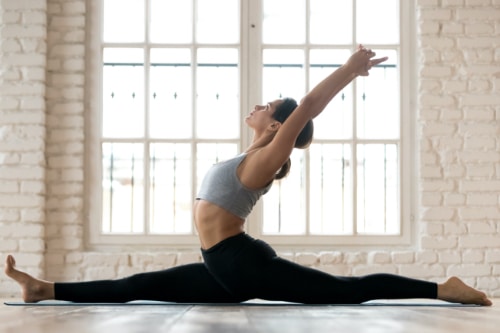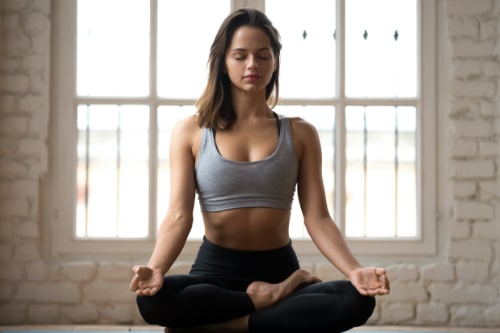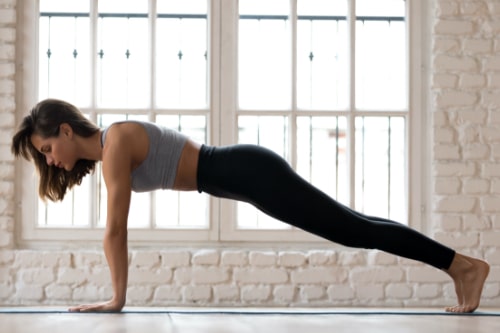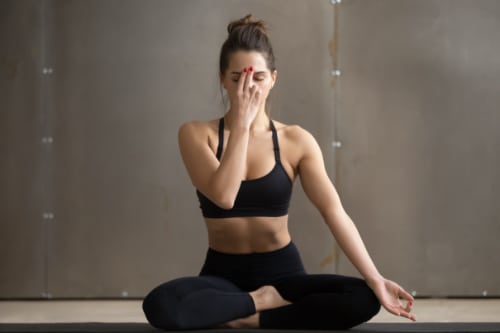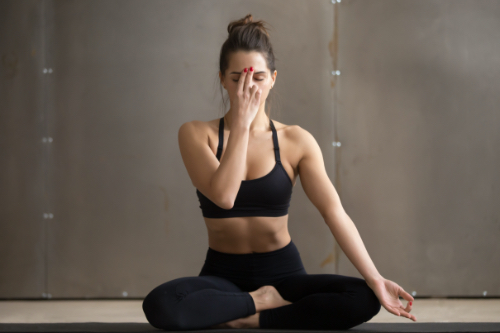
The word “yoga” means “union”. Yoga aligns the mind with the body. The benefits of yoga are both physical and spiritual. Yoga is a practice that has existed since time immemorial. Today, yoga is recognized as a means to healthy and wholesome living. Different types of yoga practised all over the world focuses primarily on enhancing inner well-being and physical health.
You can practice different types of yoga in the comfort of your home and reap all its benefits. The best part about yoga is that you need just a mat and half an hour every day to get started on this path.
These days, different types of yoga are used as a therapeutic tool to treat physical and mental problems. Yoga is not restricted to a particular religion or community. If you search online, you can find that there are different types of yoga for specific health issues which are known as ‘Therapy Yoga’.
Search options will lead you to yoga for back pain, yoga to reduce belly fat, yoga asana for weight loss, and even weight gain. These are a set of physical postures and breathing exercises which impact your concern areas and eradicate the problems.
However, they are offshoots of different types of yoga listed below:
Hatha Yoga
The Sanskrit word Hatha means “force.” Hatha yoga restores the balance of the body. This type of yoga works on the harmony between the chakras and energy points. The chakras are vortexes of energy or the points in our body where the energy lies concentrated. They are present in seven different locations in the body and are connected to specific organs and glands.
Hatha yoga comprises an extensive set of physical postures and positions that bring balance to the body and mind. The different types of yoga popularised by different schools and teachers have one commonality. They all help you to destress, stay physically fit and agile, make you look younger as yoga purifies and heals your system from within.
The different types of yoga forms borne out of hatha yoga are:
Ashtanga Yoga
Ashtanga yoga is derived from sage Patanjali’s Yoga Sutras. Known as the yoga form for weight loss, the word Ashtanga is generated from the number eight. Aashtanga yoga has eight pillars: Principles, personal discipline, asana and postures, pranayama, withdrawal, concentration, meditation and salvation.
Some of the common different types of asanas practiced in ashtanga yoga are:
- Padmasana
- Simhasan
- The Butterfly
- Kapalbhati pranayama
- Anulom vilom pranayama
- Surya bhedi pranayama
- Chandra bhedi pranayama
If you are looking for yoga for anxiety and stress relief, or yoga for upper back pain or lower back pain, or yoga for fat loss, ashtanga would be the best for you.
Vinyasa Yoga
This form of yoga is also called “flow” yoga. The word “Vinyasa” can be broken into two, with Vi meaning variation, and Nyasa meaning within prescribed limits.
Vinyasa yoga incorporates movement and breathing techniques. It creates a flow of postures with controlled breathing. The flow depicts the flow of life. Vinyasa yogis initiate the flow with a child’s pose and terminate the flow with the death pose (the savasana). The transitions into each posture reflect the movement through life. Meditation can be incorporated into vinyasa yoga practices to make movements more mindful.
For a beginner in vinyasa yoga, the ideal sequence would be:
· Plank pose (Kumbhakasana),
· Knees-Chest-Chin Pose (Ashtanga Namaskara),
· Cobra pose (Bhujangasana)
· Downward-Facing Dog pose (Adho Mukha Svanasana).
Vinyasa yoga is a good choice for the ones who like high-intensity exercises. Vinyasa yoga is ideal for anxiety, depression, blood pressure and sleep.
Kundalini Yoga
Also known as the “yoga of awareness,” kundalini yoga includes repetitive poses. The purpose of kundalini yoga is to awaken your kundalini Shakti. This is the spiritual energy located at the base of the spine. Many kundalini yogis consider the kundalini Shakti to be like a coiled snake, unaroused at the base of the spine. The active energy moves up the spine, and contributes to your spiritual well-being. Kundalini yoga is also good for stress, anxiety, depression and better cognitive function.
Movements begin with a chant, followed by pranayama, the act of controlled and precise breathing. Then comes kriya, a set of postures or mudras (specific positioning of the hand). It is followed by pranayama, chanting, and meditation.
Jal neti kriya is a cleansing technique that helps remove mucus and other blockages from the nasal passage.
Benefits of Yoga
The benefits are too many. Yoga, unlike other forms of exercise, becomes a way of life. Terms like yoga glow, yoga abs, yogic calmness have become popular over the years. Someone who practices yoga over a period of time, actually sees a huge difference in her body and the way she feels. Some of the universal benefits of yoga are:
· A sustained practice results in weight loss
· Improved blood circulation which improves skin quality and texture
· Delays overall ageing and is restorative by nature
· Improves physical stamina
· Good for gut health and improved digestion
· Improves fertility and reproductive health
· Improves sleep cycle
· Makes you calm and happy
· Improves concentration
· Reduces stress
· Improves immunity
Four main paths of yoga:
1. Karma Yoga
Karma yoga is one’s path of devotion to selfless work. This is called the yoga of action. This requires one to devote time, energy, and effort to any task. There should not be any expectation of a reward or approval. It is considered a humbling practice as one works not for the ego, but for the greater good.
2. Jnana Yoga
This is known as the yoga of intellectual knowledge and practical wisdom. Jnana yoga outlines the methods to self-realization and actualization through meditative awareness. One experiences knowledge and develops intuitive wisdom. One learns to separate the Ego from the true Self.
Jnana yoga comprises three main stages:
- Sravana (hearing or exposing oneself to knowledge),
- Manana (thinking and revisiting the knowledge for enhanced understanding),
- Nididhyasana (meditation).
Jnana yoga may not be physically challenging, but it is one of the most difficult forms of yoga to practice, as it requires an open mind.
3. Raja Yoga
In Sanskrit Raja Yoga literally translates to ‘Raja’, which means king. Raja Yoga is also known as ‘classical yoga’, ‘king of yogis’ or ‘yoga of the mind’.
The word Ashtanga alludes to the number eight and ashtanga yoga also comprises of eight steps:
#1 Yama (Principles)
#2 Niyama (Personal Discipline),
#3 Asana (Positions and Postures),
#4 Pranayama (Breathing Practices),
#5 Pratyahara (Withdrawal),
#6 Dharana (Concentration),
#7 Dhyan (Meditation),
#8 Samadhi (Salvation).
Asanas can be practiced and polished over time to achieve perfection. Some of the common asanas practiced in ashtanga yoga are Padmasana (the lotus pose), Simhasana (the lion pose), Bhadrasana (the butterfly pose, etc.).
There are many breathing exercises included under pranayama, like Kapalbhati, Anulom Vilom, Surya Bhedi, Chandra Bhedi, etc.
If you are looking for yoga for anxiety, stress relief or back pain, ashtanga is what you should go for.
4. Bhakti Yoga
Bhakti comes from bhaj, which means to worship or love God. Some people consider bhakti-yoga a way to liberate themselves from the eternal birth and death cycle. Treading this spiritual path helps unite one’s soul or ‘atman’ with Brahman or ‘true reality.’
Depending on the type of Bhakti you choose to follow, you identify as a particular type of devotee or bhakt.
- Artha – one who is distressed
- Artharthi – one who wants materialistic wealth
- Jijnasu – the curious one
- Jnani – the self-aware one
Some Contemporary Yoga Forms
Yoga in the modern world has evolved and branched out into specific practices.
1. Face yoga
Involves massages and exercises that work the muscles of your face to soften and relax them to shake off stress, tension, and worry. This form of yoga has become popular in the last few years. The followers are of the opinion that this form of yoga reverses ageing and makes you look younger by a decade at least.
2. Bikram Yoga
Named after Bikram Choudhury, Bikram yoga is a system of hot yoga that is made of twenty-six postures. It is known as hot yoga because it is practiced in a room with a temperature of 105oF (or 41oC) with a humidity of 40%. The heated temperature results in quick weight loss.
3. Yin Yoga
Yin yoga is the result of the mingling of principles derived from martial arts and yoga. This form increases blood circulation in the joints and improves flexibility and muscle tone. Postures are held for at least a minute, and through practice, one can hold the same posture for five minutes or more. Yin yoga also makes resourceful use of props like blocks and blankets, and hence is known to be practiced post-workout due to its ability to relax the body’s joints.
4. Yang Yoga
Yang yoga is relatively less experimental and is the offspring of Hatha yoga, Vinyasa yoga, and Ashtanga yoga. This is a form that is more energetic than Yin Yoga and focuses on cultivating vigor, endurance, easing out the tension in the body, and building muscle mass.
5. Power Yoga
Power yoga derives its roots from ashtanga yoga. Yoga postures are performed at a much quicker and more active pace. It works to tone the muscles and also enhances flexibility.
6. Restorative Yoga
This form of yoga uses props for body support. Restorative yoga aims to relax completely into the various poses. The idea is to hold them for a few minutes. Guided meditation is an important part of restorative yoga. The main focus of restorative yoga lies in downregulating the nervous system. A great form to actively de-stress and calm those anxious nerves.
7. Prenatal Yoga
The goal of prenatal yoga is to reduce the discomfort and pains that are associated with pregnancy. Prenatal yoga teaches some handy breathing exercises that can be quite helpful during labor. Some techniques taught in prenatal yoga can also be used as postnatal yoga. This helps new mothers to lose some weight gained during pregnancy.
There are different types of yoga for everyone. Find out the yoga technique that works best for your needs with the guidance of a certified yoga trainer. Do remember that the benefits of yoga can not be felt in a month. It is a long-term commitment. Once you get involved and regular, you will never want to give up on yoga.

